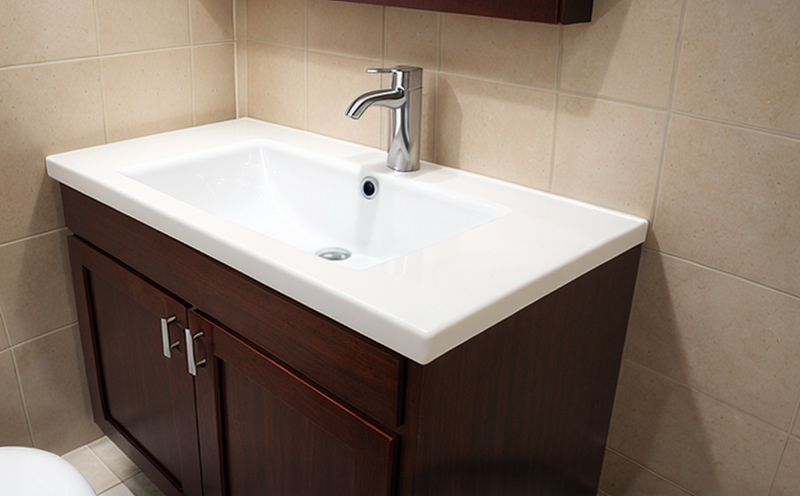ISO 4589 Oxygen Index Testing of Bathroom Plastics
The ISO 4589 Oxygen Index (OI) test is a critical procedure used to evaluate the flammability properties of materials, particularly plastics. This test is essential for ensuring that bathroom plastics meet stringent safety standards and comply with international regulations designed to protect users from fire hazards.
Bathroom plastics are exposed to various environmental conditions, including high humidity, frequent cleaning, and potential exposure to heat and chemicals. The ISO 4589 Oxygen Index Test provides a standardized method to assess how these materials react under controlled oxygen levels, simulating real-world scenarios that could lead to fire risks.
During the test, specimens of bathroom plastics are placed in a chamber where oxygen concentration is gradually reduced until combustion ceases. The oxygen index value indicates the minimum percentage of oxygen necessary for sustained combustion. This value serves as an important indicator of the material's flammability and helps manufacturers design products that meet safety requirements.
The ISO 4589 Oxygen Index Test is widely recognized in industries such as plumbing, fixtures, and home improvement. Compliance with this test ensures that bathroom plastics are safe for use in residential environments, contributing to overall fire safety standards.
For quality managers, compliance officers, R&D engineers, and procurement specialists involved in the development or sourcing of bathroom plastics, understanding the nuances of the ISO 4589 Oxygen Index Test is crucial. This test not only helps in meeting regulatory requirements but also ensures product reliability and user safety.
Scope and Methodology
The scope of the ISO 4589 Oxygen Index Testing specifically targets plastics used in bathroom fixtures such as shower curtains, bathtub liners, toilet seats, and other similar applications. The testing methodology follows a rigorous set of steps aimed at ensuring accurate results.
- Specimen Preparation: Specimens must be cut to standardized dimensions (typically 100 mm x 25 mm).
- Oxygen Concentration Control: Oxygen concentration is reduced in increments, starting from approximately 21% down to a value that stops the combustion process.
- Combustion Initiation: Combustion is initiated by igniting the specimen at one end with a small flame. The time taken for the fire to reach a specific point on the opposite side of the specimen is measured.
- Oxygen Index Calculation: The oxygen index is determined as the lowest concentration of oxygen that allows continuous combustion.
The testing apparatus includes a vertical furnace, an oxygen supply system, and a means to measure time. Compliance with international standards like ISO 4589 ensures accurate and reliable results.
Acceptance criteria for the test include a minimum passing value of the oxygen index that varies depending on the type of plastic and its intended use in bathroom fixtures. This acceptance criterion helps ensure that only materials meeting strict safety requirements are used.
Why Choose This Test
- Enhanced Safety Standards: Ensures compliance with international standards, contributing to fire safety in residential environments.
- Rigorous Testing Methodology: Utilizes a standardized approach that guarantees accurate and consistent results across different laboratories.
- Regulatory Compliance: Helps manufacturers meet stringent requirements set by governing bodies worldwide.
- Product Reliability: Provides data to support the development of reliable, high-quality bathroom plastics.
- User Confidence: Builds trust among consumers knowing that their products are tested for safety and reliability.
The ISO 4589 Oxygen Index Test is a cornerstone in ensuring the safety and quality of materials used in bathroom fixtures. It plays an essential role in protecting users from potential fire hazards, thereby enhancing overall product performance and satisfaction.
Environmental and Sustainability Contributions
The ISO 4589 Oxygen Index Test not only focuses on immediate safety but also contributes to environmental sustainability by promoting the use of materials that are inherently safer. By ensuring that bathroom plastics meet stringent flammability standards, this test indirectly supports efforts towards a more sustainable built environment.
- Reduced Fire Risk: Materials with higher oxygen index values burn less easily, reducing the risk of accidental fires in homes and public spaces.
- Eco-Friendly Design: The use of safer plastics can lead to the development of more sustainable bathroom fixtures, contributing to a greener building sector.
- Longevity: Products made from materials that pass this test tend to be more durable, reducing waste and encouraging recycling practices.
Incorporating ISO 4589 Oxygen Index Testing into the production process aligns with broader sustainability goals by fostering innovation in material science. This approach ensures that bathroom plastics not only meet safety standards but also contribute positively to environmental conservation efforts.





